| enter keyword to search: |
|
Images db
|
|
|
Articles db
|
|
|
|
|
|
|
|
|
Once left Paucartambo village we soon reached the mountain ridge, a great natural balcony on the Amazonian basin. Known as Acjanaco, this place offers a spectacular view of breathtaking beauty. The clouds - literally at our feet - emerged from the jungle in their ascent to the mountains. Leaving the Acjanacu pass, which marks the beginning of the Cultural Zone of Manu Biosphere Reserve, we found ourselves suddenly enveloped in clouds that floated down to rest in the Cloud Forest. After a long descent from the Acjanacu pass, we spent our first night in the open-air lodge of San Pedro.
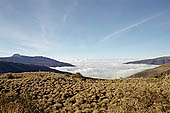
|
Acjanacu pass |
In the morning we visited one of the two nearby Cock-of-the-Rock leks (courtship sites) to watch the dawn mating rituals of these spectacular birds (Rupicola peruviana), Peru's national bird. The male birds are a vibrant reddish orange, and at about 5:00 a.m. as many as several dozen come together for an exhibition of a mating ritual dance. The males display their crest, showing off and posturing for the females. The females, fewer in number, watch to select the most suitable males. Up to 20 males congregate at this spot to display.
The lodge is situated in the pristine Cloud Forest home of the Cock of the Rock, Spectacled Bear, Orchids, Tree Ferns, at least 50% of the plant species found here are endemic to this region, c. 80 species of Orchids are recorded around the lodge. We were also able to spot some beautiful tanagers.
From the lodge the road leads down between waterfalls and canyons toward the town of Pilcopata, a small frontier village of Andean colonists and indigenous people whose main economic activities are subsistence agriculture and selective logging. After lunch we continued by bus at a ruined bridge where we had our White-water rafting down the turbulent KoshŮipata River and the spectacular KoŮeq Canyon. Continuing down the Alto Madre de Dios river finally we arrived to Erika Lodge where we spent the second night. From here the only transport is by river.
Erika Lodge |
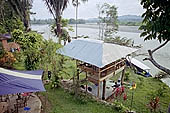
|
In the morning we sat in the garden of the lodge waiting for the passing flocks of mixed-species of birds, while enjoying the ever-present hummingbirds. Erika Lodge is located in a transition zone between high and low jungle (600 m.a.s.l. to 1,150 m.a.s.l) encompassing different habitats. This altitude range explains the high diversity of wildlife found around this lodge, it is possible, walking near the riverbanks, to observe insects, medicinal plants, trees, and make good bird watching.
From the lodge with a boat trip down the Alto Madre de Dios River, sometimes pushing the canoe through the shallows, we arrived at Boca Manu, a nice small village with some shops. Boca Manuís village is situated a short distance from the confluence of the Manu River with the Alto Madre de Dios River. After the short stop we set off again in the canoe and entered in the Manu River and the Reserved Zone. In the lodge near Limonal we spent the third night. During that night we had the possibility to spot an almost tamed capybara.
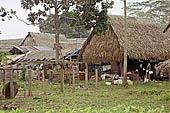
|
Boca Manu |
We where able to spot several white caimans along the river shore from the boat. The indios tend to kill them when encountered, although they are not eaten. We so also a healthy specimen nearly full-grown. After registering in the official tourist logbook at Limonal, the Park Rangers Headquarters, we visited the Lake Salvador, the five-kilometres long Salvador Lake is the largest and beautiful oxbow lake in the lower Manu River. With a small catamaran we had the chance to spot a family of Giant Otters. We were able to see these playful and gregarious carnivores from the catamaran and from the pier. We spent the forth night in a campsite immersed in the forest.
Lake Salvador |
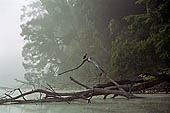
|
We cross the river to walk a trail in the forest to another oxbow lake, Lake Otorongo. There a 15 meters high observation tower rises above the lake and the jungle, giving us more chances to observe wildlife. We visited also some dwellings nearby the river where we met a couple of indios families, selling some of their artefacts to the passing by tourist groups. The huts have been provided by an international project to help native to benefit from the tourism. Interesting the traditional musical instruments like the pegompi, a mouth violin. The one-stringed instrument is held between the teeth and bowed with the vein of a palm leaf. By opening and closing the mouth, the player produces an eerie modulation of the droning tone, used as a focus of meditation during the shamanistic trance produced by ayahuasca vine. On the beach along the river we saw sometimes temporary encampments, during the dry season, the families of a larger community tend to disperse, taking advantage of the ample beaches and low water to fish and seek buried turtle eggs. We spent our fifth night at the same camp at Salvador Lake. Nearby, half an-hour walking in the forest, we went to the Tapir Clay Lick, to which 1-6 tapirs usually come on dry nights, this is the best place in the world to see these amazing beasts, which are the largest terrestrial animals in South America, but we had no luck. Instead on the same night, with the help of flashlights, we were able to spot the jaguar. In the Manu region, the Inca Indians deeply respected these fierce cats. The jaguars symbolized power, strength, and beauty. Incas in Cusco used the jaguar image in their coat of arms.
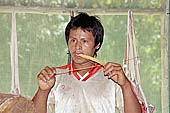
|
indios dwellings
|
From the camp we descended the Manu River returning to Boca Manu by midday. From here we descend the Madre de Dios River. During the trip we were lucky enough to spot again the jaguar from the boats. The cat were resting on the shore, we saw him with our binoculars for a long time until he felt disturbed and went away showing us his fury tail. We spent the sixth night at a wild camp set on the sandy shore of the river.
Madre de Dios river |
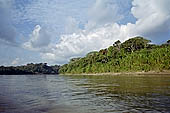
|
After an early wake up, we board a camouflaged catamaran and go down the river to the "Collpa" macaw lick. This is the most easily approached and photographed large macaw lick in the world. We quietly observe the various parrots feeding on the clay for mineral and salt supplements to their diet of seeds and fruits. The brightly coloured macaws usually wait patiently in the surrounding trees until the smaller parrot species have left the area. Slowly, the macaws come down to the clay wall to feed. Around mid morning we board our canoe to return to the airstrip at Boca Manu. At this point, those who were returning to Cusco by plane caught their flight. We continued up the Alto Madre de Dios River to camp on a sandy beach of the river for the seventh night.
The last day we continued the trip by boat to Atalaya, where we boarded the bus that drove back up and out of Manu, arriving in Cusco the next day early in the morning spending uncomfortably our eight and last night on the bus.
This was our Manu, several days' canoe journey down the snaking rivers of the Madre de Dios department.
|
Related Pages
††-
††-
††-
††-
††-
††-
††-
††-
|
|
|
 |
|
|



